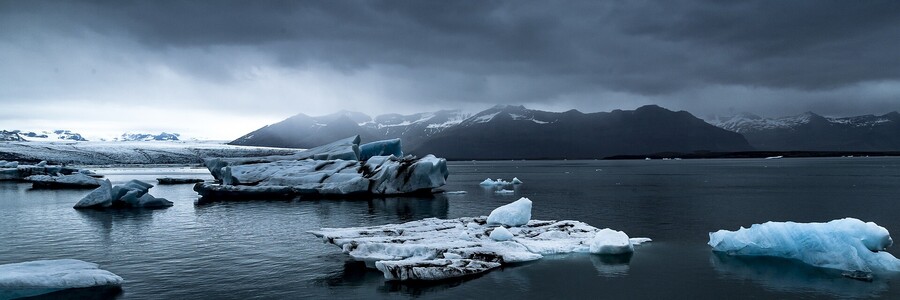Why are glaciers important?
Ice acts like a protective cover over the Earth and our oceans. These bright white spots reflect excess heat back into space and keep the planet cooler. In theory, the Arctic remains colder than the equator because more of the heat from the sun is reflected off the ice, back into space.
Glaciers around the world can range from ice that is several hundred to several thousand years old and provide a scientific record of how climate has changed over time. Through their study, we gain valuable information about the extent to which the planet is rapidly warming. They provide scientists a record of how climate has changed over time.
Today, about 10% of land area on Earth is covered with glacial ice. Almost 90% is in Antarctica, while the remaining 10% is in the Greenland ice cap.
Rapid glacial melt in Antarctica and Greenland also influences ocean currents, as massive amounts of very cold glacial-melt water entering warmer ocean waters is slowing ocean currents. And as ice on land melts, sea levels will continue to rise.
What is the difference between sea ice and glaciers?
Sea ice forms and melts strictly in the ocean whereas glaciers are formed on land. Icebergs are chunks of glacial ice that break off glaciers and fall into the ocean.
When glaciers melt, because that water is stored on land, the runoff significantly increases the amount of water in the ocean, contributing to global sea level rise.
Sea ice, on the other hand, is often compared to ice cubes in a glass of water: when it melts, it does not directly change the level of water in the glass. Instead, depleting Arctic sea ice triggers a host of other devastating consequences—from depleting available ice on which walrus can haul out or polar bears hunt to changing weather systems around the world by altering the pattern of the Jet stream.
Why are glaciers melting?
Since the early 1900s, many glaciers around the world have been rapidly melting. Human activities are at the root of this phenomenon. Specifically, since the industrial revolution, carbon dioxide and other greenhouse gas emissions have raised temperatures, even higher in the poles, and as a result, glaciers are rapidly melting, calving off into the sea and retreating on land.
Even if we significantly curb emissions in the coming decades, more than a third of the world’s remaining glaciers will melt before the year 2100. When it comes to sea ice, 95% of the oldest and thickest ice in the Arctic is already gone.
Scientists project that if emissions continue to rise unchecked, the Arctic could be ice free in the summer as soon as the year 2040 as ocean.
What are the effects of melting glaciers on sea level rise?
Melting glaciers add to rising sea levels, which in turn increases coastal erosion and elevates storm surge as warming air and ocean temperatures create more frequent and intense coastal storms like hurricanes and typhoons. Specifically, the Greenland and Antarctic ice sheets are the largest contributors of global sea level rise. Right now, the Greenland ice sheet is disappearing four times faster than in 2003 and already contributes 20% of current sea level rise.
How much and how quickly these Greenland and Antarctic ice sheets melt in the future will largely determine how much ocean levels rise in the future. If emissions continue to rise, the current rate of melting on the Greenland ice sheet is expected to double by the end of the century. Alarmingly, if all the ice on Greenland melted, it would raise global sea levels by 20 feet.
How do melting sea ice and glaciers affect weather patterns?
Today, the Arctic is warming twice as fast as anywhere on earth, and the sea ice there is declining by more than 10% every 10 years. As this ice melts, darker patches of ocean start to emerge, eliminating the effect that previously cooled the poles, creating warmer air temperatures and in turn disrupting normal patterns of ocean circulation. Research shows the polar vortex is appearing outside of the Arctic more frequently because of changes to the jet stream, caused by a combination of warming air and ocean temperatures in the Arctic and the tropics.
The glacial melt we are witnessing today in Antarctic and Greenland is changing the circulation of the Atlantic Ocean and has been linked to collapse of fisheries in the Gulf of Maine and more destructive storms and hurricanes around the planet.
What are the effects of melting glaciers and sea ice loss on humans and wildlife?
What happens in these places has consequences across the entire globe. As sea ice and glaciers melt and oceans warm, ocean currents will continue to disrupt weather patterns worldwide. Industries that thrive on vibrant fisheries will be affected as warmer waters change where and when fish spawn. Coastal communities will continue to face billion-dollar disaster recovery bills as flooding becomes more frequent and storms become more intense. People are not the only ones impacted. In the Arctic, as sea ice melts, wildlife like walrus are losing their home and polar bears are spending more time on land, causing higher rates of conflict between people and bears.
Source:
https://www.worldwildlife.org/pages/why-are-glaciers-and-sea-ice-melting

